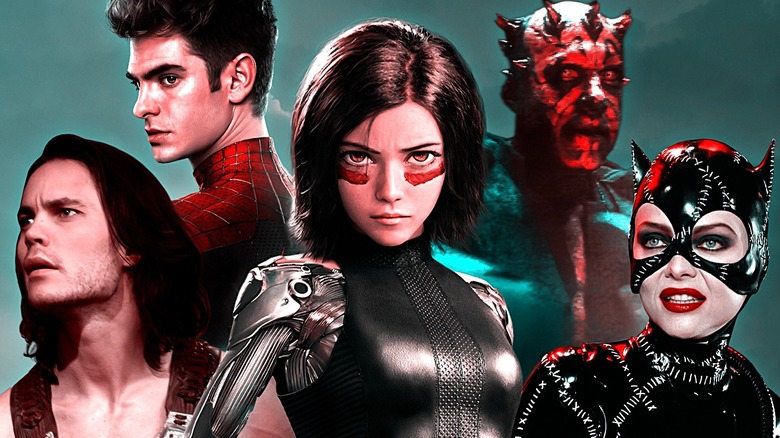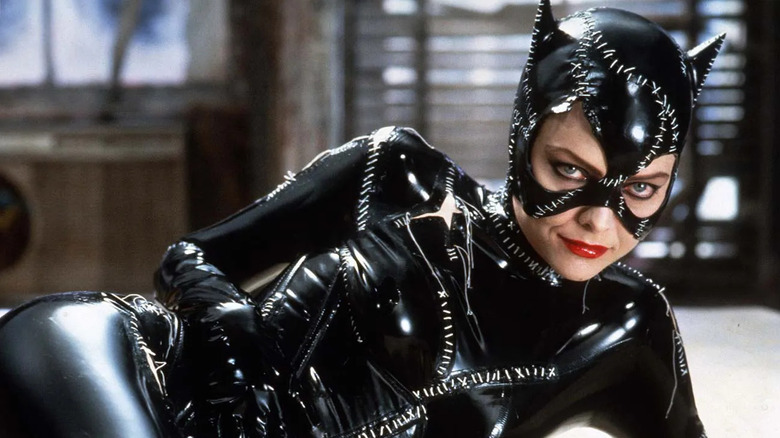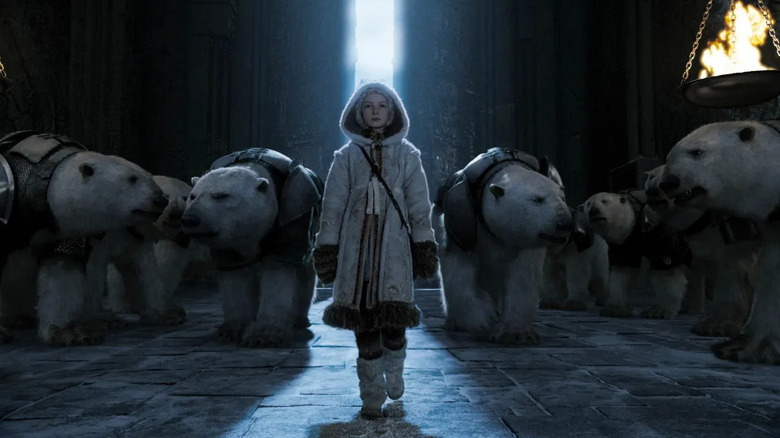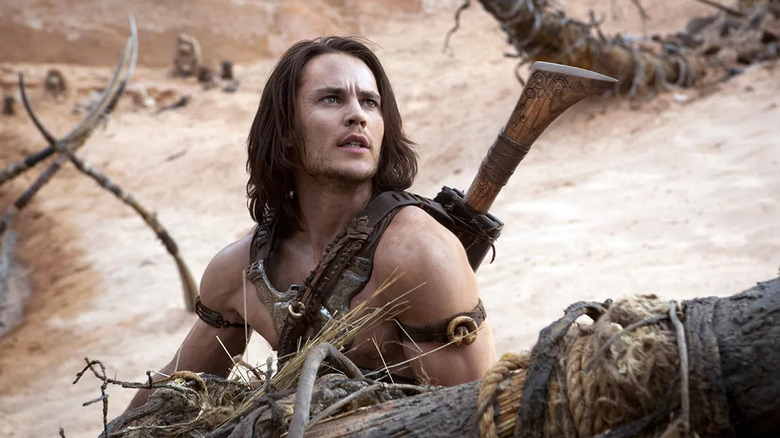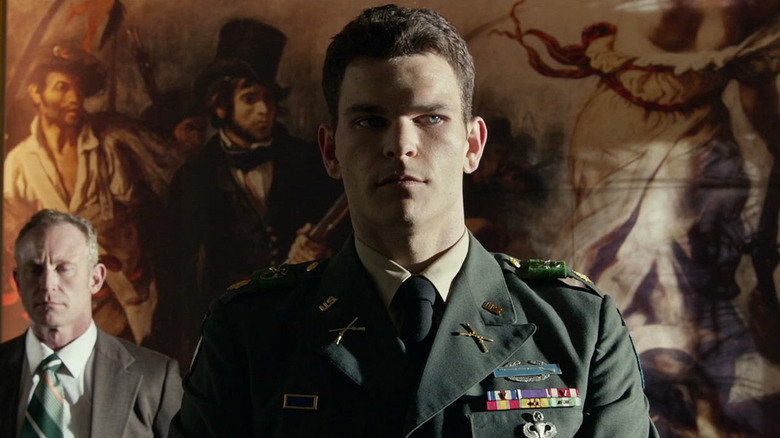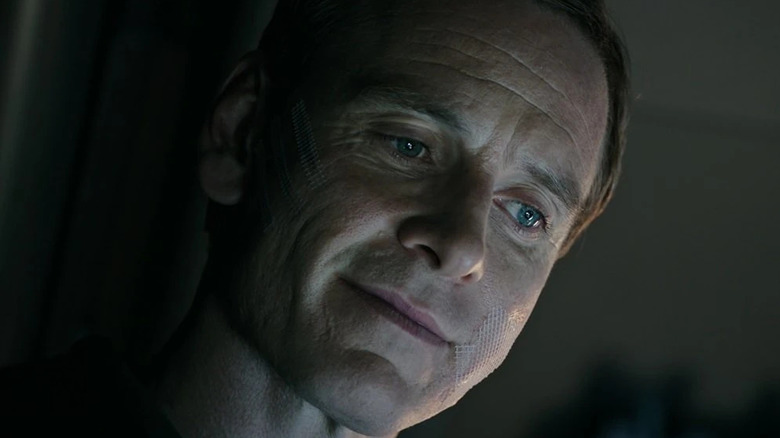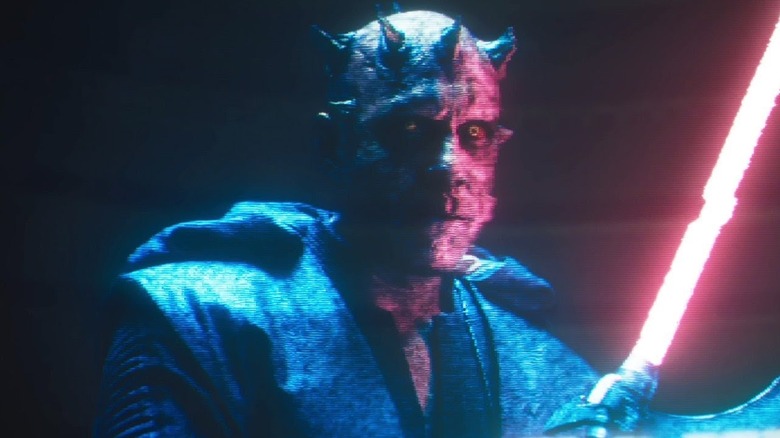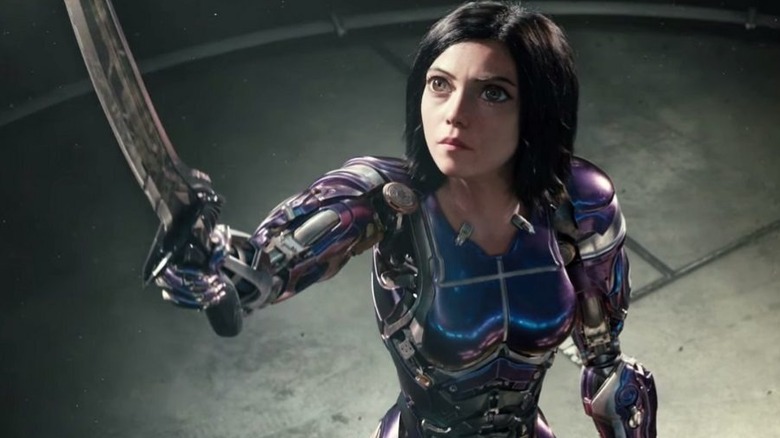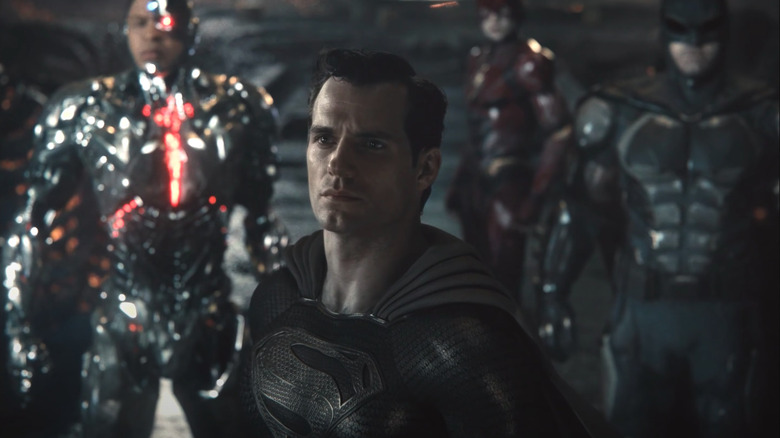15 Movie Cliffhangers That Were Never Resolved
In terms of cinema, there's nothing more frustrating than jumping aboard a potential franchise, only to see studio heads pull the plug due to poor critical reception, underwhelming box office, or negative fan backlash. Surprisingly, this happens a lot, with an assortment of properties left dangling without a proper resolution to their storylines.
Typically, the fault lies with the producers, who too often put the cart before the horse and spend far too much time setting the stage for future sequels and spinoffs rather than focusing on laying a solid foundation for their property. And so, we're left with a bevy of incomplete films that vanish into the void — often leaving a lot of unrealized potential on the table.
We've perused the cinematic landfill for examples of this unfortunate filmmaking staple and found 15 noteworthy cliffhangers that were never resolved. So grab some popcorn and take a look — and don't worry, our list actually has a conclusion.
Batman Returns (1992)
Even in the early '90s, Hollywood was giving us cliffhangers with no payoff. In this case, "Batman Returns" ends with our hero (Michael Keaton) defeating the Penguin (Danny DeVito) and Catwoman (Michelle Pfeiffer), both of whom appear to perish during the finale.
Later, Bruce cruises through Gotham City's snow-covered streets with Alfred (Michael Gough), but then leaps from the vehicle when he spots a familiar cat-like shadow on the side of a nearby building. Alas, Bruce finds a stray cat and nothing more, bids his butler a merry Christmas, and drives away.
The camera then pulls up until it emerges above Gotham, where the Bat Signal flashes across the sky, followed by Catwoman, who rises into the frame, adorned in her costume, evidently having not spent all nine of her lives. Leaving the theater, viewers no doubt expected more adventures with the sultry villainess.
Unfortunately, director Tim Burton was done waving his freak flag and handed the franchise reins to Joel Schumacher, resulting in the decidedly Catwoman-less "Batman Forever." She's mentioned in passing, but her absence is never satisfactorily explained.
Super Mario Bros. (1993)
Hollywood Pictures went all in on 1993's "Super Mario Bros.," starring Bob Hoskins and John Leguizamo as the famed plumbers, Mario and Luigi, dumping nearly $50 million into the production and bringing in the talented Dennis Hopper to play King Koopa. No doubt, expectations for a franchise were high, leading directors Rocky Morton and Annabel Jankel to conclude the film with an unresolved final tag.
A few weeks after saving Dinohattan, our heroes are enjoying their newfound success, only to be interrupted by a gun-toting Princess Daisy (Samantha Mathis), who says, "You gotta come with me, I need your help — you're never going to believe this!" Mario grabs his belt, and we're left wondering what their next adventure might have looked like. Daisy looked worse for wear, clad in torn pants and brandishing one helluva gun and a "Terminator"-esque grenade belt. Did King Koopa return? Are there other dimensions that need saving? Sadly, we'll never know, leaving this interesting exercise without a proper ending.
The Golden Compass (2007)
Jumping ahead to 2007, we find another would-be franchise that never got off the ground — "The Golden Compass," Chris Weitz's star-studded big-screen adaptation of the first book in Philip Pullman's "His Dark Materials" trilogy. While not necessarily a flop, the picture failed to generate much interest in the United States, causing New Line Cinema to pull the plug on future sequels despite stronger international numbers. Furthermore, the studio was absorbed into Warner Bros., as it could no longer function independently.
So, basically, all that time spent with those massive polar bears, watching Daniel Craig look at books in the library, and getting introduced to the broader aspects of Pullman's intricate universe was all for naught. We never even get a sense of what Lord Asriel (Craig) accomplishes during his fleeting screen time, as the film cuts the explosive and emotional climax from Pullman's "Northern Lights." Instead, we see Lyra soaring toward Asriel in a balloon before cutting to the credits. Audiences are left wondering about the true nature of Dust, the deeper motives of the Magisterium, and why the hell Nicole Kidman bothered to sign onto this project in the first place.
District 9 (2009)
Neill Blomkamp's "District 9" marks the weirdest entry on this list, specifically because it A) teases a sequel that has yet to hit the pre-production stage, and B) made enough money to warrant a continuation. Costing a mere $30 million to produce, this sci-fi action drama earned $210.8 million at the box office and scored four Academy Award nominations. Moreover, it's often considered one of the best in the genre by cinephiles.
At any rate, when the main character of your story — in this case, the genial Prawn, Christopher — says he'll return in three years, you better bring him back in three years! And yet, here we are, well over a decade later, and poor Wikus van de Merwe (Sharlto Copley) is probably still residing in the South African city of Johannesburg as a mutated Prawn, making metal flowers for his wife. Blomkamp teased development on a follow-up in 2021, though, considering the number of disappointing legacy sequels we've received over the years, it might be best to leave this one alone.
The Last Airbender (2010)
M. Night Shyamalan was the wrong man to direct "The Last Airbender." Though he shows some creativity in the fight sequences and provides James Newton Howard enough meaningful content to produce a top-flight score, his trademark flat dialogue bogs down what should have been a magical adaptation of Nickelodeon's animated television series "Avatar: The Last Airbender." His controversial casting decisions didn't help matters. Basically, "The Last Airbender" was doomed from the start.
Toss in a fiercely negative — and perhaps unwarranted — response from critics, who Shyamalan claimed didn't "get" the film, and a good-but-not-great performance at the box office, and it all but guaranteed this franchise would never get off the ground.
Fans are then left to wonder where the sequels might have gone if given the chance (or they could just watch the cartoon), as the film ends by introducing a new villain — Fire Lord Ozai's daughter, Azula (Summer Bishil) – who is tasked with hunting down and capturing the Avatar. Prince Zuko's (Dev Patel) arc is never fully resolved, and Aang (Noah Ringer) never gets the chance to master Earthbending or Firebending.
Green Lantern (2011)
The superhero genre is loaded with dangling cliffhangers that were never resolved. For every Nick Fury cameo, we received two or three post-credit cookies like the one found in 2011's "Green Lantern," promising more adventures with the titular hero (played by Ryan Reynolds) that never came to fruition after middling reactions to the movie.
For those who haven't seen this admittedly confusing Martin Campbell-directed disaster, the scene in question sees Mark Strong's Sinestro acquire the yellow ring, transforming him from Hal Jordan's mentor into an out-and-out villain. In the comics, the disillusioned leader forms the Sinestro Corps and tries to institute a universe governed by fear. Strong's performance was good enough to leave us eager for more of his character.
Unfortunately, "Green Lantern" made just $220 million against a colossal $200 million budget, all but ensuring the franchise didn't continue. Maybe next time, don't have a giant cloud as your primary antagonist?
John Carter (2012)
"John Carter" is a unique film. On the one hand, the Andrew Stanton production offers a faithful adaptation of Edgar Rice Burroughs' novel, "A Princess of Mars." On the other hand, since so many films and TV shows borrowed from Burroughs' story, "John Carter" felt like a retread of better films ... that ripped off "John Carter." Ironic, no?
Consequently, the massive budget and bland marketing of "John Carter" (and a lot of other factors) made achieving a profit an impossible task, and it became one of the biggest bombs in cinema history. Disney nixed follow-ups, leaving many questions unanswered. What was the larger plan of the Therns? Why did they target John Carter (Taylor Kitsch) in the first place? Was there a deeper war brewing across Barsoom? When we last see him, John has successfully faked his death and uses a secret medallion to return to Mars. What happens next? Do they live happily ever after? Barring a miracle, we'll likely never see the rest of the story — at least not until the inevitable television reboot.
Chronicle (2012)
"The Blair Witch Project" may have initiated the found footage genre, but Josh Trank's sublime 2012 superhero epic "Chronicle" took the concept to its peak. Written by Max Landis, this unique story follows three friends who develop superpowers after coming into contact with a mysterious object. Weeks pass, and the trio grows in strength and even gains the ability to fly. For a while, everything appears to be on the right track.
However, Andrew (Dane DeHaan), the troubled third member of the group, slowly descends into villainy, using his powers to exact revenge on bullies and his alcoholic father, forcing his friends — namely Matt (Alex Russell) and Steve (Michael B. Jordan) — to take him down. A massive city battle commences over Seattle that leaves Matt as the lone survivor. We then cut to a few months in the future, where Matt promises to find the source of their power before shifting the camera used to document the entire affair to focus on a Tibetan monastery in a manner that screams, "To be continued," though it obviously wasn't.
The Amazing Spider-Man 2 (2014)
Watching 2014's "The Amazing Spider-Man 2," it's pretty clear that no one had any idea where to take the story. Instead, Marc Webb and about a half-dozen screenwriters tossed every concept they could at the screen in the hopes something would stick. And so we get a bloated, jumbled superhero epic packed to the brim with characters, teases for spin-offs and future sequels, plot threads that go nowhere, and a handful of alternate endings that only further demonstrate the incompetence of the production.
Don't blame Webb, who likely had his hands full trying to mix the story he wanted to tell with the film the studio heads ordered him to make. At one point, Harry Osborn/Green Goblin (Dane DeHaan) receives a visit from a mysterious man named Gustav Fiers (Michael Massee), who offers the young villain a chance to join his team — a clear tease at Sony's long-gestating but never realized "Sinister Six" picture, which would've seen Spider-Man's (Andrew Garfield) rogue's gallery team up, "Suicide Squad"-style. As of now, that project is dead, which makes the constant intrusions in "The Amazing Spider-Man" films all the more irritating.
X-Men: Days of Future Past (2014)
Believe it or not, there was a time when the "X-Men" franchise actually made sense. Now, the long-running mutant saga has seen numerous reboots, sequels, and spinoffs that play fast and loose with continuity. Honestly, it's best to view each entry as its own thing rather than a direct continuation of anything that came before.
Take "Days of Future Past," for example, which marked the heralded return of Bryan Singer following his short-lived stint with "Superman Returns." Here, we see Wolverine (Hugh Jackman) travel back in time to the 1970s to prevent a war from occurring in 2023. To achieve his goal, he must team with a young and disillusioned Professor X (James McAvoy) and Magneto (Michael Fassbender) to stop Mystique (Jennifer Lawrence) from assassinating a powerful political figure (Peter Dinklage). Long story short, our hero accomplishes his mission but winds up stuck at the bottom of the Potomac River, where he is later fished out by Major William Stryker (Josh Helman), setting up his Weapon X storyline — right?
Not really. See, it turns out Stryker is not actually Stryker, but instead Mystique disguised as Stryker. It's a fascinating development that teases a possible alternate future. Except this plot beat is never referenced again. When next we see Wolverine in "X-Men: Apocalypse," the poor guy is once again in his Weapon X form. So, who knows what the hell Singer was planning with that odd twist?
The Mummy (2017)
You gotta hand it to the Marvel Cinematic Universe for successfully creating a cinematic footprint no other studio has been able to replicate — though many have tried. The most egregious example, of course, being Universal Studios' aborted Dark Universe, which would have brought together movies revolving around their classic monsters in an "Avengers"-style fashion.
Predictably, the studio's first feature, 2017's "The Mummy," flopped so badly that all plans were scrapped, despite casting announcements that included big-name stars like Johnny Depp, Russell Crowe, and Javier Bardem. None other than Tom Cruise paved the way for this joint venture, starring as U.S. Army sergeant Nick Morton, who eventually transforms into a mummy following a long battle with Princess Ahmanet (Sofia Boutella). The final scene finds our weary hero alive and well, seeking a cure alongside his resurrected pal Chris (Jake Johnson).
Like so many other pictures on this list, the filmmakers were so busy setting up their universe that they forgot to deliver a quality project, ultimately wasting a game Cruise in a bland, joyless exercise that pales in comparison to Stephen Sommers' colorful 1999 picture starring Brendan Fraser.
Still, we can't help but wonder the darker corners Universal's Dark Universe might have traversed had it succeeded — or, we could just check out the Dark Universe theme park.
Alien: Covenant (2017)
Kudos to Ridley Scott for having the guts to take the "Alien" franchise in a novel (some would say essential) new direction with "Prometheus" and "Alien: Covenant." Rather than produce another Xenomorph slasher, the acclaimed director decided to go the prequel route and explain the origins of the alien creature, focusing on the Space Jockey — er, Engineer — we saw in "Alien," while also zeroing in on David (Michael Fassbender), a deranged synthetic dealing with a God complex.
Regrettably, the execution of these ideas left much to be desired, as neither picture is smart enough or scary enough to fully satisfy fans of either high-concept sci-fi or traditional horror. Poor box office returns ultimately stalled Scott's budding saga, leaving a handful of dangling plot threads that may or may not ever be resolved.
Indeed, in the final moments of "Covenant," David actually wins, impersonating the synthetic Walter and trapping poor Daniels (Katherine Waterston) in a cryochamber — an entire colony of people now available for his dastardly experiments. We're dying to see the conclusion of this story. What happens to Daniels? What does David do with his alien creations? Will he make a cameo appearance in Fede Alvarez's sequel to "Alien: Romulus"? Fingers crossed.
Solo: A Star Wars Story (2018)
Fans were over the moon when Disney acquired "Star Wars" and immediately set out to expand George Lucas' sprawling universe. After a slew of content best described as mediocre, it's hard to get excited about future entries.
That said, one direction the Mouse House could take that might reignite enthusiasm would be continuing the plot thread established in "Solo: A Star Wars Story" — namely, that Darth Maul (Ray Park, with voice by Sam Witwer) is the mysterious force behind Crimson Dawn. The iconic character, who first appeared in "Star Wars: Episode I — The Phantom Menace," popped up for a brief cameo (via hologram) at the tail end of "Solo," revealing his cybernetic legs and patented red lightsaber. He doesn't do much beyond telling Qi'ra (Emilia Clarke) that they will be working closely together from now on, but it was still fun to see the horned villain on the big screen again.
And yet, that's likely the last time we'll see Maul in that capacity, due to "Solo" flopping hard at the box office — forcing Disney to pivot away from additional adventures with young Han Solo (Alden Ehrenreich).
Alita: Battle Angel (2019)
"Alita: Battle Angel" never lives up to its potential, mainly as a result of Robert Rodriguez's flat direction and a rather generic story. Sure, the film looks great thanks to Weta Digital's impressive visual effects, but something was clearly lost in translation in this adaptation of Yukito Kishiro's manga series.
Perhaps that's why "Alita" only managed to break even at the box office, thus stalling plans for a sequel that would have seen our CGI heroine (Rosa Salazar) exact revenge on Edward Norton's Nova for orchestrating the death of her friend Hugo (Keean Johnson). The last act of this sci-fi tale spends a great deal of time setting up the next film, making "Alita" difficult to enjoy as a standalone feature — unless, of course, you've read the source material.
Criticism aside, there is potential here for great cinema. With introductions out of the way, an "Alita" sequel would allow Rodriguez to really sink his teeth into the material.
Zack Snyder's Justice League (2021)
Finally, with all due respect to James Gunn's "Superman," Warner Bros. was foolish to pull the plug on Zack Snyder's DC universe. While his films were never colossal, Marvel-sized hits, they raked in more money than any DC film produced after his departure and set the stage for something truly unique.
"Zack Snyder's Justice League" brings together Batman (Ben Affleck), Superman (Henry Cavill), Wonder Woman (Gal Gadot), Cyborg (Ray Fisher), Aquaman (Jason Momoa), and Flash (Ezra Miller) to bring down Steppenwolf (Ciarán Hinds), all the while teasing Darkseid (Ray Porter) as a greater threat. Snyder revealed his plans for his "Justice League" sequels, and it's a shame we will never get a chance to see his vision play out. His films were never perfect, mostly due to studio interference, but they were incredibly ambitious and very different than anything we've ever seen in this genre.
Who knows? Maybe WB will let Snyder finish his story via an animated series sometime in the not-so-distant future. At least we got "ZSJL," which is a gargantuan success anyway you slice it.
